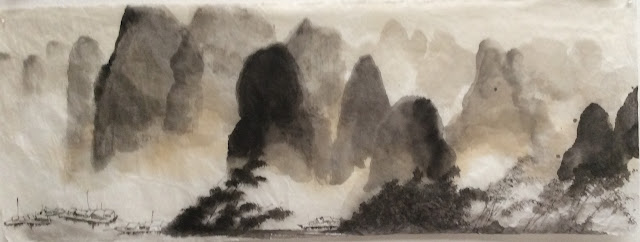I wanted to paint a flight of spiral staircase.
A bunch of concentric circles; well maybe not entirely concentric, but think of it as a bunch of circles of different diameters placed together. How difficult could it be.
I was asked the reason for picking this subject matter. It really does not have a whole lot to do with Chinese brush painting. So why bother.
My short answer was that I wanted to continue to explore the property of the semi-sized Xuan that I was using, and to continue my study of the
Jimo (accumulating ink) technique.
Actually the spirals with radiating spokes of steps and alternating bands of illuminated flat surface against vertical dark balustrade fascinated me. To me, there existed complexity in this simplistic arrangement, and vice versa.
The schematic was too complicated to paint extemporaneously, so I took my time to sketch it out. I wanted a reasonable spatial proportion and relationship of the different elements.
Next step was to build up the details by writing in the steps. To help me perceive the perspective better, I painted in the floor at the bottom, designating that as the darkest portion, and began to build my risers from the bottom up.
I continue to construct until all the steps were in. I felt like I was installing vanes in a jet engine.
It was time to test the water. Like a proud parent, I introduced my piece to my cohorts.
I had done a few pieces of works with ink and semi-sized Xuan, namely the roof top piece and the pillars piece. Those pieces were done in the portrait format.
Why couldn't I turn my painting 90 degrees to the left and make it into a portrait format too. After all it's just a bunch of circles so the orientation should not matter! By doing this, I could add to my collection of ink paintings in the portrait format.
To my chagrin, the reception was lukewarm at best.
Is that a pupil of an eye? Mused someone.
It looked convex to me! If you were trying to paint stairs, they appear to be poking out the painting rather than looking down Commented another.
You need to blur out the top levels so the bottom is in focus, so people get what you are painting! Suggested yet another.
So I monkeyed around with it and dramatized my light values to better illustrate my helical steps.
Still looks like an eye! There's something wrong with your painting but I couldn't put my finger on it ! That was pretty much the general consensus.
Then the art professor came over and rotated my painting 90 degrees.
Now everybody went Ah! Much better!
What I thought was a bunch of circles and the orientation didn't matter actually did matter in this instance. I thought hard and long for my misconception.
Here is plausible explanation.
When we are looking down a flight of spirals, we are inevitably closest to one point on the rail or banister. As we gazed downwards, the corresponding points on each ring would seem to stick together. For example, when we looked through a tunnel or a huge water pipe, we typically see the
ceiling curving around us, and the floor of the pipe seemed flat, even though it is part of the circle.
By displaying this painting in a portrait format, we took away that point of reference and our brain could not rationalize the anomaly and cried foul. Order was restored only when we restored that frame of reference.
You just can't fool the eye! Nor the pupil, for that matter.













